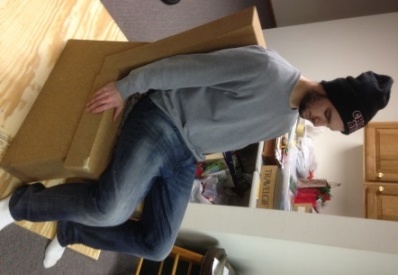WEB NOTE: All of the things that we may have seen cut by a waterjet cutter have been made of metal. But recently that device cut several 6” slabs of cork. Why cork? And who would do that? Alex Zeppieri, a civil engineering senior with an art minor, explained how he came to have thick chunks of cork cut in the Engineering Machine Shop. Here is his story.
By Alex Zeppieri
Civil Engineering Senior
I'm a 5th year civil engineering major, Art minor, who will be graduating in May 2015. Because I chose the architectural Elective Focus Area, I have taken several 3D design classes that are held in the Studio Arts Building.
This semester I took Environmental Design 1, but it is widely known as Furniture Design. On the first day of class Monica

It took a lot of looking to find a distributor that sells large pieces of cork, but I finally found a company in New York that carries all types of cork. I used high density tan cork blocks, which are used for decoy carving. I also decided to use cork fabric to cover the chair cushion. So the first requirement of two sustainable materials was met.
A second requirement was that the pieces of the chair had to be cut by CNC routing. Any type of CNC router would be okay (e.g., waterjet, saw, laser, etc.). Since the CNC routers at the in woodshop would accommodate material only 2 inches or less thick, I had to use the waterjet at the EMS. With modifications from Mike Hillman, a student employee in EMS, we were able to get the 6 inch cork slab on the waterjet. I cut 4 pieces -- 2 legs, 1 seat, and 1 back -- from 4 slabs of cork. The legs each used a 2' x 3' x 6" piece, while the seat and back used 2' x 3' x 4" pieces.
My chair design was very basic but still required several modifications. I designed the chair using AutoCAD after just learning 3D in AutoCAD from Professor [Colby] Swan. Even though I am a 5th year engineering major, I found the process from design to actual construction was absolutely amazing. I learned how designing something as simple as a chair can be extremely detailed and require precision.
For this project time and money were the constraining factors. With limited time and money, I could not build exactly what I wanted, could not make a perfect product. Scheduling is a very important part in this project, too, as the chair has to be completed by the end of the semester. Those constraints meant that I relied on Engineering Machine Shop staff, especially Mike, to successfully waterjet cut the cork slabs before I headed home for Thanksgiving break. Mike’s cutting of the cork was 100% successful, and he knew the waterjet software like he had written it himself. This project pushed the limits of engineering and architecture, and I believe my cork chair illustrates my success.
Over the Thanksgiving break I sanded the pieces, and lined the seat and back with a cork fabric cushion. I am using wood and steel dowels to assemble the chair, but those connectors should not be visible in the final product.
As a civil engineering and 3D design student, I am impressed and grateful for the facilities, machines, tools, and staff that have contributed to my education. For this project I got to learn a lot about the waterjet cutter, how it works and the software it uses. It was very pleasing to see the 3D AutoCAD drawings represented perfectly in the real-life pieces.
Credit for help on this project:
Jelinek Cork Group, Nancey Brunton-Law (provided cork slabs & cork fabric from NY)
Wildlife Urn (provided cork slabs from Minnesota)
Mark Williams (provided woodshop tools/machines; family friend in Rockford, IL)
Steve Struckman, Bill Jennings, and Mike Hillman (EMS waterjet cutting techs)